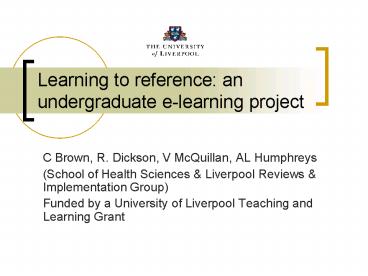Learning to reference: an undergraduate e-learning project - PowerPoint PPT Presentation
1 / 13
Title:
Learning to reference: an undergraduate e-learning project
Description:
... e-learning project. C Brown, R. Dickson, V McQuillan, AL ... '99, Greenhalgh '01, Lewis '01, Steele '02, Hahne '05, Calverley '03, Vichitvejpaisal 01) ... – PowerPoint PPT presentation
Number of Views:17
Avg rating:3.0/5.0
Title: Learning to reference: an undergraduate e-learning project
1
Learning to reference an undergraduate
e-learning project
- C Brown, R. Dickson, V McQuillan, AL Humphreys
- (School of Health Sciences Liverpool Reviews
Implementation Group) - Funded by a University of Liverpool Teaching and
Learning Grant
2
Why?
- Two concerns
- Weak academic writing
- Evidenced throughout all years of the program
despite significant feedback on assignments - Plagiaristic behaviour
- Our experience
- University guidelines
- Lessons from the literature
3
Program design assumptions
- Adult learning theory
- Flexible
- Student controlled
- Multi-media
- Demonstrably relevant
- High reward (50 of assignment mark)
- Sufficient support
4
Learning to Reference resources
- Seven audio-visual modules archived in Horizon
Wimba - 1 introduction
- 2 rationale and basics of referencing
- 4 Using EndNote software
- Accessed through VITAL module link
- Tracking
- Supporting material
5
Findings (n52)
- Access to computers
- 92.2 university libraries
- 86.3 at home
- 27.5 public library
- 70 own mobile phones, digital TVs, Digital
camera, MP3 players - 70 use PCs, e-mail and the internet daily
- 80 perceived current IT Skills as sufficient
6
Uptake
- self-report indicated lt30 uptake of 1st 2
modules - Reasons given too busy (58.7), left it too late
(34), prefer print material (26.1), already
know how (19.1)
7
And so?
- Students report sufficient IT literacy
- Students report a perceived need
- The incentive was high
- Access to the resource was flexible
- No one attended for in-person assistance
8
We built itbut no one came
When it comes to Self-directed E-learning, the
indefatigable human spirit (that lives in every
lecturer) is not enough
9
What the literature has to say about our new
question
- Uptake is a frequent problem
- (Ehrmann 94, Devitt 99, Greenhalgh 01, Lewis
01, Steele 02, Hahne 05, Calverley 03,
Vichitvejpaisal 01) - Students dont always identify technical problems
- Fear
- Peer pressure
- Cost/benefit analysis
- (Selim 2003, Van Braak 2004, McNulty et al 2006)
10
Mistaking IT literacy for readiness
- Here and now orientation (why spend time now?)
- Buy into better than a class-room
- Additional disincentives
- Telephone costs (most used home/halls)
- Competing demands
- Peer norming
- Learning style
11
Things to considerif it were that simple word
would have gotten around (Derrida in Cilliers
1998)
- Computer assisted learning is complex
- Be clear about motives
- Be aware of the time teaching demands
- Supporting Best Practice in E-Learning across the
NHS (2005) - a flexible, inquisitive attitude to a range of
learning mediums (particularly CBL) must be
instilled in training - 2 Key needs
- staff skills to design, deliver develop
- Student skills to undertake e-learning
12
Teaching competencies, Teaching capabilities
- Competencies- demonstrable, measurable skills
- Capability defensible confidence to
problem-solve in both known novel contexts
(Phelps et al 2005) - We assumed competent with IT transferable and
built capability - Is the NHS making the same assumption?
- Skills training attitudes and beliefs
13
Recommendations
- Focus on user engagement (before content).
- What mediates engagement (CWAM?)
- Not all students are Adult Learners
- Schedule
- Is it really taught best by e-learning?
- Student culture- students as part of design team.
- Learning what you dont know (continuous
assessment opportunities)































